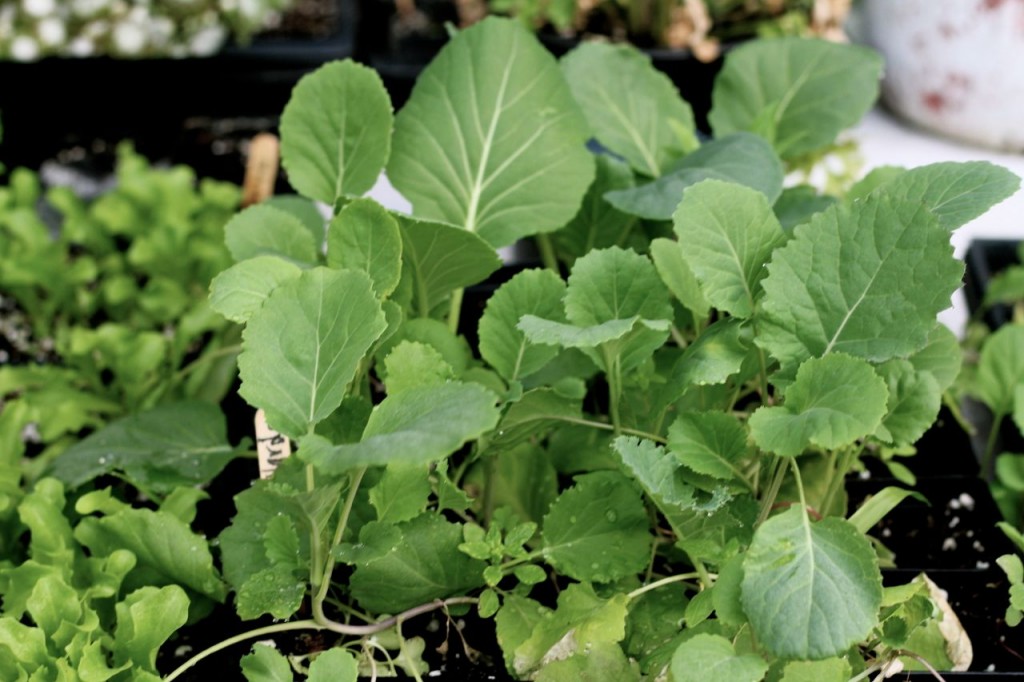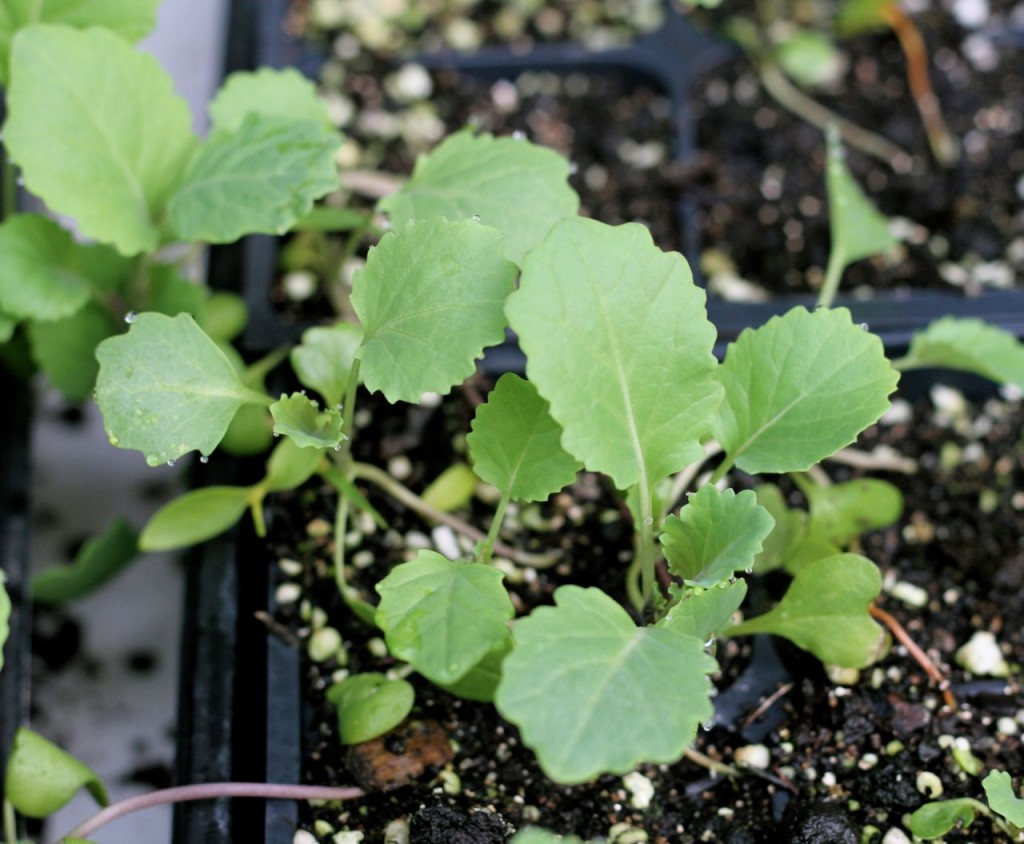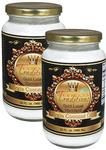Collards, the hot “new” superveg, and a greens recipe that you will crave!
Collards are such a boon to good health, I’m really glad that they have recently been “discovered” and are being touted as a super-vegetable. Our grandmas knew this all along (especially those living in the south!): that you should eat your leafy greens every day, and that collards are an excellent choice of said greens. The rest of us are just catching up to this fact. Thanks, Grandma. 🙂
Here are a handful of reasons that you ought to grab some collards the next time you’re at the farmer’s market, if you don’t do this already (or, plant some in your garden: it’s not too late!).

These collard plants will go into the garden this week, just so I have plenty for this recipe!
Consider for yourself, that the humble collard greens:
- are good sources of vitamin C and soluble fiber, and contain multiple nutrients with potent anticancer properties, such as diindolylmethane and sulforaphane.
- are low-calorie! A whopping quarter-pound of collards, cooked, only has 46 calories. 🙂
- are antiviral and antibacterial.
- are an excellent anti-inflammatory food.
- are loaded with carotenoids, Vitamin K, Vitamin C, Vitamin E, folate, and manganese.
- are even more nutritious in many areas than kale! *gasp* It’s true. 🙂
You probably hear a lot about the negative effects of inflammation if you do any nutrition reading at all. Inflammation can play a role in many health conditions that we in the Western world are plagued with: cancer, diabetes, Alzheimer’s disease, arthritis and heart disease. So–eating lots more anti-inflammatory foods (and avoiding the foods that cause inflammation) can really help lower your risk of struggling with these conditions (reference: “International Journal for Vitamin and Nutrition Research”).
You may be struggling with inflammation without even realizing it! Do any of these conditions sound familiar?
- joint pain
- arthritis
- headaches
- high blood pressure
- general “flu”-like symptoms
- fatigue
- muscles aches that don’t go away
It’s easy to focus on adding more low-inflammation foods to your diet–there are lots of them–and to learn how to prepare them in a way that you love. Even better, if you plant them in your kitchen garden, you’ll be reminded to eat them, and you’ll have a steady supply of collards all summer long!
I had to put that in green, just because. 🙂
Another quick garden note: I’m growing two areas of collards in my garden this summer, I love them so. One bed I’ll let get full-sized, to use in these types of recipes, and one (ala my friend Gene’s technique) I’ll grow with kale, mustard, endive, radicchio, etc., and clip as baby leaves for flavorful salads. (I’ll write about it more later, I promise!) 🙂

These baby collard greens will go into my “baby greens” bed, with endive, a couple kinds of mustard greens, and a couple kinds of kale (again, Gene’s idea).
But. To know and to do are two separate things, aren’t they? So you’ve heard that collard greens, for example, are an excellent anti-inflammatory food, but what do you do with them? I did a quick perusal of recipes online for collard greens, and found mainly recipes that involve stewing the greens for hours with ham hocks: sounds like Southern comfort food to me, and probably is very tasty, but not something I can make quickly. Plus, I suspect that you lose most of the health benefits when you stew them that long.
My self-imposed challenge this summer: how to pack as many anti-inflammatory foods as possible into my family’s daily diet, without spending the whole day in the kitchen. Cause (you’re with me, right?) I don’t have the whole day. I might have half an hour today, tops, to throw together a quick lunch. Maybe even less tomorrow, come to think of it.
(I’m trying to get my garden in, and with the rainfall being pretty amazing this spring, the mowing and weeding chores are never-ending already!) Not that I’m complaining. I LOVE being out in my garden again, even if I’m just covered with mud and pulling weeds. So. Happy. There. Please, kids, don’t call me into the house until October. 🙂
I learned a lot about eating a diet rich in anti-inflammatory foods when my sister and I were cooking for a family member who was having some health problems a couple of years ago. Collards were high on our list of go-to foods, but to prepare them in a way that keeps their low-inflammatory qualities, we couldn’t just toss them in a pot with a ham hock and cook them to soggy submission.
My sister shared a recipe with me that is so delicious and so easy to make, I (literally!) crave collard greens if I don’t make this every few days. (Thanks, Anne!) I tweaked the recipe just a bit (as is my wont) but the idea is the same. I make these for lunch whenever I’m craving a big “mess of greens.”
Which. Is. Often. 🙂

Oh and by the way, the iris are blooming at our place!
And, as is my wont, I’ll share the recipe with you! And . . . you’re gonna love it.
*deep curtsey*
- 3 tsp coconut oil
- 1/2 medium onion, diced
- 1 bunch collard greens, stems removed, cut into ribbons
- 1/2 cup coconut milk
- 1/2 tsp freshly ground salt
- fresh grated coconut (optional)
- Heat coconut oil in large cast iron skillet over medium-high heat.
- Reduce heat and add onion and cook, stirring frequently, for 10 to 15 minutes, or until golden brown and very soft.
- Add greens and coconut milk; cook, stirring frequently, for 10 minutes, or until greens are very tender.
- Add salt to taste.
- Sprinkle with optional coconut, if desired.
- Eat while hot!
Oh my, and I nearly forgot to mention 😉 that the Gold Medal Virgin Coconut Oil from Tropical Traditions is on sale, too, in the quart sizes–buy one get one free! This is a great way to try out this excellent coconut oil, which ought to be part of your daily diet, too, along with those leafy greens!

Click here to get some for yourself, and to learn more. (affiliate link)
Oh hey, you: do me a favor and share this with your friends today, okay? They’ll love you for it! 🙂 And who doesn’t like to be loved?
That’s all for today, Gentle Readers. Happy cooking!
*hugs*
- search terms that brought you to me (hehee)
- Juicing for Idiots (and backwards country types–like you-know-who . . .)


My first foster parents were from Oklahoma and sure knew greens. We lived with them for three years and ate a lot of collard greens, mustard greens, swiss chard and kale among other healthy foods. In those days there was no such thing as “super foods”. They did not eat beef or pork so ours were pretty much seasoned with salt, pepper and a little lemon juice. As kids, they were maybe not our favorite foods but now we really enjoy them. Your recipe is a winner that we will be sure to try very soon here in Mexico. Thanks for sharing. We are still planting and have some room for more greens. At the moment my wife is putting a little basil in our pillows. We have been told it will help with a restful sleep and we don’t have any lavender available.
Yum! I can’t wait to try this recipe. And coconut oil is also good for you, so this has healthy written all over it! 🙂
I love mine with chili flakes, garlic and ACV. I bet your would be great with some ginger added too! I’ll try it as soon as I see some fresh collards at the market.
I think I could handle this recipe. I have been wanting to try collard greens, but was not sure how to best prepare them. Plus, some of the stewing recipes make the end result look unappetizing.
This recipe cooks up pretty fast, Charissa, so the collards stay pretty and green.
Wow this has been a very informative post! Coconut collards sound delicious! Thanks so much for joining the Link-It To Me Link Party, I hope you will party with us again next week!
Thanks Chantal, I’ll try to!